
Taking the next step
October 24, 2013
By
Andrew Macklin
When Nicolas Ng and John Loewen started Methes Energies almost a decade ago, they had little knowledge about making biodiesel and even less working capital.
When Nicolas Ng and John Loewen started Methes Energies almost a decade ago, they had little knowledge about making biodiesel and even less working capital. After years of research, studying the market and analyzing the technology, Methes Energies is almost ready to open its first full-size biodiesel production facility, which uses its own patented technology.
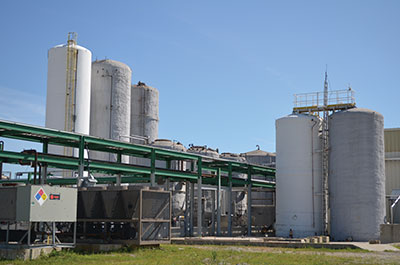 |
|
| Methes Energies’ new biodiesel plant is located on the former Chinook Chemical site in Sombra, Ont.
|
In 2004, there wasn’t a ton of activity in the biodiesel market in Canada. There was no government mandate for the use of biodiesel, nor was there any established quality standard. The United States was a different story, and that was where Ng and his partner saw an opportunity. They began doing research online to understand the process and how difficult biodiesel would be to make. From their research, it looked as if it were fairly easy to make, so they went and bought a few reactors to begin the process.
“We tried to make biodiesel ourselves to get to know the process,” explains Ng. “We quickly found out that it was actually very difficult to make biodiesel, especially on the commercial level. We found out it was even more difficult to meet the ASTM (American Society for Testing and Materials) specifications.”
The complexity of the process caused Ng and Loewen to spend the first 18-24 months as a company learning the process of making biodiesel fuel that would meet ASTM requirements and be a marketable product in North America. During that time, they realized that because competing with major manufacturers across Canada and the U.S. would not be realistic at this stage in the life of their company they would have to find a niche for themselves within the biodiesel marketplace.
“We figured out that, if there is a way we could develop a product to help an entrepreneur get into the biodiesel industry, there are places in North America and Europe where a small-scale production facility could make sense economically,” says Ng.
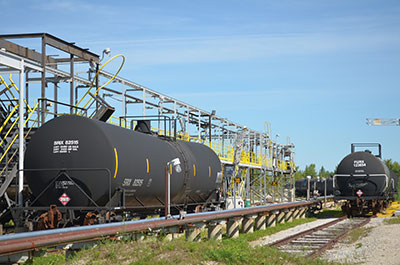 |
|
| The existing rail infrastructure at the former Chinook Chemical site was one of the most appealing features that led to Methes Energies’ purchase of the property. |
As a result, Methes Energies then went on a different path: one that would provide a framework for entry into the biodiesel market. After months of research and development, the company created a system that would fit the market by producing five million litres of biodiesel per year: the Denami 600 biodiesel processor.
Once the system was developed, the team at Methes tested a variety of high-grade and low-grade feedstocks in order to ensure that the Denami could process all of them into ASTM-grade biodiesel. The demonstration plant was constructed at their current location in Mississauga, where the company was able to test virgin cooking oil, high-grade used cooking oil, refined oils, pork fat, lard and food-grade beef tallow. By early 2008, the Denami 600 was performing up to or above company expectations with all of the feedstocks, and Methes began selling ASTM-grade biodiesel to the
commercial market.
An opportunity to expand
In 2009, with Methes having ramped up production of biodiesel at its demonstration plant in Mississauga, the company decided to look into the possibility of developing a commercial-scale plant. It wasn’t known if the expansion would take place in Canada or the United States, but it was preferred that the site be as close to the Mississauga operation as possible.
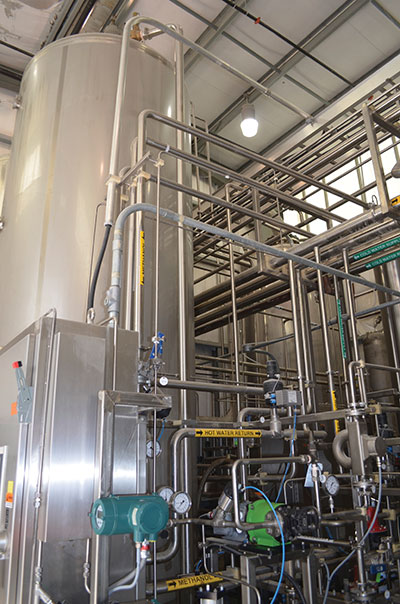 |
|
| This filtering system removes trace amounts of methanol and glycerin, an important step in meeting ASTM requirements.
|
By complete fluke, Methes had an almost perfect location fall in its lap. Nicolas was discussing the expansion plan with colleagues when a person at another table overheard the conversation and approached Nicolas. The gentleman at the other table was part of a team that was in the process of decommissioning the Chinook Chemicals site in Sombra, Ont., located south of Sarnia along the St. Clair River.
Within 15 days, Ng and his team had toured the site and purchased the facility, which appealed for three reasons: First, already on site were a number of components such as tanks and piping, many of which could be used for biodiesel production once they were cleaned. Second, the location boasted solid rail infrastructure. Finally, the proximity to the U.S. border made it easier to transport feedstocks to the site and biodiesel from the site.
In order to afford an investment in commercial production in Sombra, Methes Energies took advantage of an opportunity to get federal funding through the government’s ecoENERGY for biofuels program. The program, which committed over $1 billion to biofuel grants over a nine-year period, provided the financial investment needed to push the project forward. In September 2009, the Ministry of Natural Resources announced that Methes would receive up to $5.4 million for the project.
Getting started in Sombra
The company began work in Sombra, making minor improvements to the site such as getting electricity running, and fixing and replacing some of the piping. Once the ecoENERGY grant money was actually received, Methes ramped up its conversion efforts.
The main project that took place during the ramping-up phase was the installation of the Denami 3000. The 3000 was built to be a larger version of the 600, increasing the flow, production and footprint of the 600 without changing the core technology. Continuous flow was increased from 158 GPH to 790 GPH, for an increase from 1.3 MM to 6.5 MM gallons per year of production.
With the installation of the Denami 3000, as well as upgrades to the piping and tank infrastructure, it took Methes eight to 12 months to retrofit the site so that it was suitable for biodiesel production.
There was also work to be done in training the staff at the Sombra site. Many had worked in biodiesel production or in similar industries, but they weren’t familiar with how the new Denami 3000 would perform as part of the system. With a limited supply of feedstocks, some unfamiliar equipment and the challenge of getting the crew settled, Methes took advantage of the opportunity to begin production at a lower capacity.
“We’ve been training our crew and fixing all of the different bugs in the system that we find along the way during our small-scale production at Sombra,” says Ng.
As of September, Methes was running the Sombra facility at 25-30 per cent of maximum production. By the end of October, production was expected to hit 50 per cent, with maximum levels to be reached in the second quarter of 2014. Full capacity is expected to be 50 million litres per year.
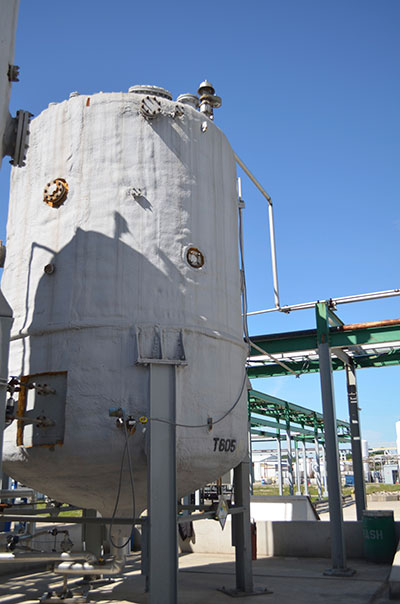 |
|
| The brownfield site appealed to Methes for several reasons, including the existing infrastructure and a rail link.
|
At least, that will be the case if Methes can find the right feedstock mix to use with the Denami 3000 based on what
is available.
“One of the challenges is finding suitable feedstocks (for the Sombra site),” says Ng. “We looked at a number of different feedstocks: some worked well, some didn’t quite work well enough. Finding the right price point also made it difficult.”
Finding a consistent and cost-effective supply of high-grade feedstock has been a constant issue for Methes as the company continues to increase production. Even in the early stages, using the demonstration plant in Mississauga, finding good feedstocks has been an issue, especially from Canadian sources. The result has been a continued battle to find suitable feedstocks, in large quantities, from American suppliers.
“We prefer to use used cooking oil, and this comes from bigger cities like New York and Chicago, where we’ll often have to buy it from brokers,” explains Ng. “The oils are being collected by the different independents and are put together at a processing facility. There we either buy it direct from the production facility or from brokers.”
While cooking oils are the preferred feedstock, there is another option available in large quantities from some Canadian suppliers: corn oil. The ethanol production byproduct is being used by some other biodiesel producers in Canada and remains a secondary option for Methes Energies’ Sombra facility.
“We have also been using corn oil from ethanol plants,” says Ng. “There are some Canadian plants that we do business with, and we have also bought corn oil from different plants in the U.S. Midwest.”
The current market
Canada still has a relatively young market for biodiesel, but the introduction of a federal mandate for its use has helped the industry
get started.
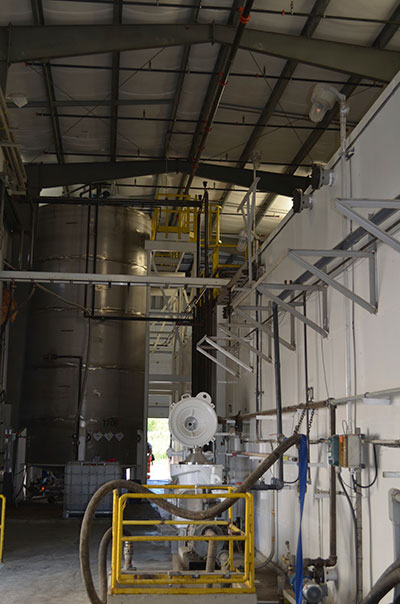 |
|
| A look inside the pre-treatment area where acid esterification takes place.
|
There is a two per cent requirement for overall usage of biodiesel in Canada. However, the overall percentage means that the fuel use does not have to be nationwide. As a result, most of the demand remains in Western Canada, where local biodiesel producers compete on price with manufacturers in the western U.S.
The logistics of exporting biodiesel to Western Canada mean that Methes does not play in that market but instead has moved most of its product across the U.S.
The cost of biodiesel from other North American markets isn’t the only factor in looking for customers. There is also an emerging renewable diesel market that is competing for the same business opportunities.
“Other than the biodiesel that is being made in the U.S., we are also competing with renewable diesel that is being produced in Finland and Singapore,” says Ng. “A good part of our Canadian mandate for diesel is not only being met by purchasing and blending biodiesel but also by purchasing and blending renewable diesel.”
That isn’t likely to change unless the federal mandate increases in Canada, which isn’t likely at this point. The issue isn’t just a push for change at the government level, but also the cost involved in the production of biodiesel. It is currently substantially higher than the cost of regular diesel.
Looking ahead
For now, Methes Energies is completely focused on getting the Sombra site up to 100 per cent capacity, regardless of what the future market looks like for biodiesel. With the second quarter of 2014 just six months away, there is still work to be done in order to get the facility ready for maximum production.
Once that is complete, Ng says that Methes will return to focusing on its original strategy: to provide systems for small-scale entrepreneurs looking to enter the biodiesel industry. Now that the company has field tested both the Denami 600 and the Denami 3000, those involved have a better understanding of what can go wrong with the implementation of the system – something that they think will be of value for potential customers looking at purchasing their technology.
At the same time, Ng realizes that they need to push forward with production and make sure that there is support for the industry in Canada: “The biodiesel industry in Canada is still very young, volumes are still very small and the industry is very fragile.” •
Print this page